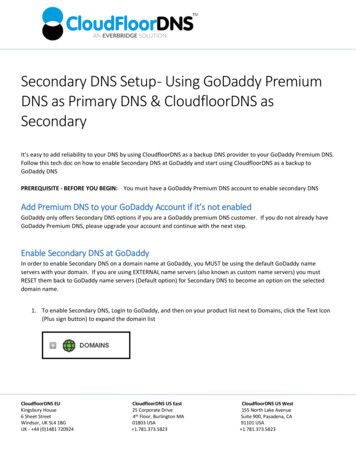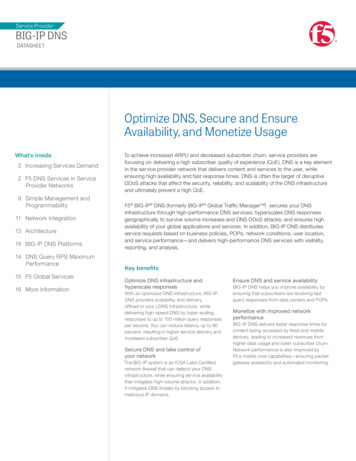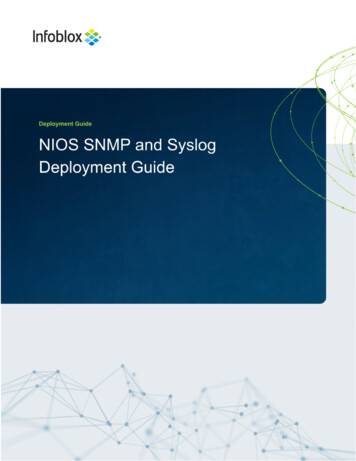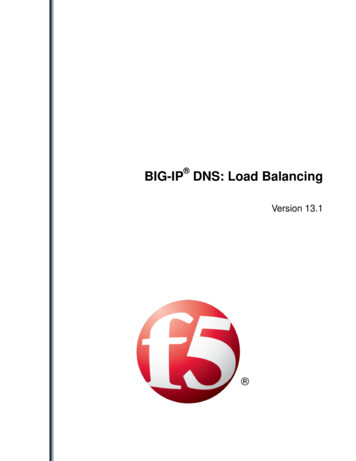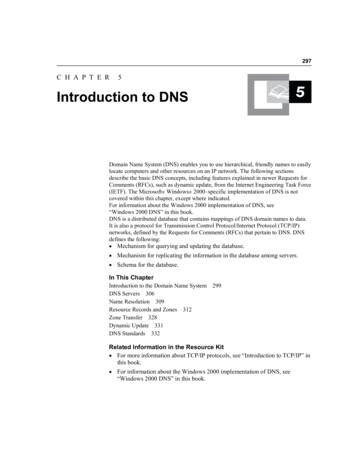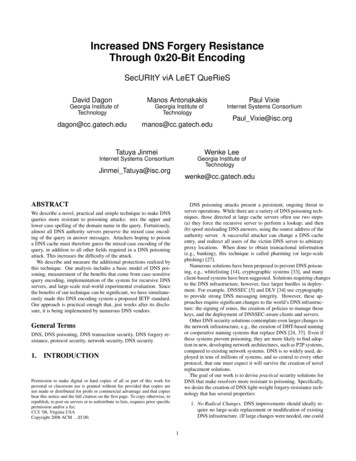
Transcription
Increased DNS Forgery ResistanceThrough 0x20-Bit EncodingSecURItY viA LeET QueRieSDavid DagonManos AntonakakisGeorgia Institute ofTechnologydagon@cc.gatech.eduGeorgia Institute ofTechnologymanos@cc.gatech.eduPaul Vixie@isc.orgTatuya JinmeiWenke LeeInternet Systems ConsortiumGeorgia Institute ofTechnologyJinmei Tatuya@isc.orgwenke@cc.gatech.eduABSTRACTDNS poisoning attacks present a persistent, ongoing threat toserver operations. While there are a variety of DNS poisoning techniques, those directed at large cache servers often use two steps:(a) they force the recursive server to perform a lookup; and then(b) spoof misleading DNS answers, using the source address of theauthority server. A successful attacker can change a DNS cacheentry, and redirect all users of the victim DNS server to arbitraryproxy locations. When done to obtain transactional information(e.g., banking), this technique is called pharming (or large-scalephishing) [27].Numerous solutions have been proposed to prevent DNS poisoning, e.g., whitelisting [14], cryptographic systems [33], and manyclient-based systems have been suggested. Solutions requiring changesto the DNS infrastructure, however, face larger hurdles in deployment. For example, DNSSEC [5] and DLV [34] use cryptographyto provide strong DNS messaging integrity. However, these approaches require significant changes to the world’s DNS infrastructure: the signing of zones, the creation of policies to manage thosekeys, and the deployment of DNSSEC-aware clients and servers.Other DNS security solutions contemplate even larger changes tothe network infrastructure, e.g., the creation of DHT-based namingor cooperative naming systems that replace DNS [24, 37]. Even ifthese systems prevent poisoning, they are more likely to find adoption in new, developing network architectures, such as P2P systems,compared to existing network systems. DNS is so widely used, deployed in tens of millions of systems, and so central to every otherprotocol, that one must expect it will survive the creation of novelreplacement solutions.The goal of our work is to devise practical security solutions forDNS that make resolvers more resistant to poisoning. Specifically,we desire the creation of DNS light-weight forgery-resistance technology that has several properties:We describe a novel, practical and simple technique to make DNSqueries more resistant to poisoning attacks: mix the upper andlower case spelling of the domain name in the query. Fortuitously,almost all DNS authority servers preserve the mixed case encoding of the query in answer messages. Attackers hoping to poisona DNS cache must therefore guess the mixed-case encoding of thequery, in addition to all other fields required in a DNS poisoningattack. This increases the difficulty of the attack.We describe and measure the additional protections realized bythis technique. Our analysis includes a basic model of DNS poisoning, measurement of the benefits that come from case-sensitivequery encoding, implementation of the system for recursive DNSservers, and large-scale real-world experimental evaluation. Sincethe benefits of our technique can be significant, we have simultaneously made this DNS encoding system a proposed IETF standard.Our approach is practical enough that, just weeks after its disclosure, it is being implemented by numerous DNS vendors.General TermsDNS, DNS poisoning, DNS transaction security, DNS forgery resistance, protocol security, network security, DNS security1.Paul VixieInternet Systems ConsortiumINTRODUCTIONPermission to make digital or hard copies of all or part of this work forpersonal or classroom use is granted without fee provided that copies arenot made or distributed for profit or commercial advantage and that copiesbear this notice and the full citation on the first page. To copy otherwise, torepublish, to post on servers or to redistribute to lists, requires prior specificpermission and/or a fee.CCS ’08, Virginia USACopyright 2008 ACM . 5.00.1. No Radical Changes. DNS improvements should ideally require no large-scale replacement or modification of existingDNS infrastructure. (If large changes were needed, one could1
and addresses. DNS is a complex protocol with numerous controlling RFCs. We therefore focus on only those details relevant toDNS forgery attacks. Readers requiring a more general overviewmay consult [31].argue that zone owners should instead just deploy DNSSEC.)2. Protocol Stability. Improvements should require no alteration of the DNS protocol, which would in turn require reimplementation of DNS server and client code. (Surveys haveshown there are tens of millions of DNS servers deployedworld-wide, many on embedded devices [8, 25]. Amendingthem to handle a new protocol is likely cost-prohibitive.)2.1 DNS OverviewIn DNS, domain names are composed of labels, separated by periods, which correspond to namespaces in a hierarchical tree structure. Each domain is a node, and the bottom-up concatenation ofnodes creates a fully qualified domain name. A zone is collectionof such nodes, constituting a separate tree structure, with the zone’sstart of authority, or SOA, at the apex. The contents of the SOA (either mappings of labels to hosts, or further downward delegation),is available from “DNS authority servers”. In DNS nomenclature,these authority servers are sometimes called the SOA.There are two other DNS resolvers typically involved in poisoning attacks: recursive resolvers, and (less frequently) stub resolvers.A recursive resolver is what one normally thinks of as a “DNSserver”. Such resolvers accept queries from users, understand thezone hierarchy system, and properly implement the various rulesand RFCs to obtain and cache answers.DNS initiators on host machines are called stub resolvers. Theytypically don’t interact with the zone hierarchy, and with a few exceptions, don’t cache answers. Instead, they implement enoughDNS logic to pose basic queries to recursive servers.A short example illustrates how these three classes of DNS systems interact. Assuming no intermediate caching, resolving a domain name like www.example.com potentially requires numerous steps:3. Backward Compatible. Any improvements should be optional, and not disrupt other technologies that rely on existingDNS standards.We present a defense technique against poisoning that satisfiesthese requirements. We propose the mixed-case encoding of queryand reply messages between recursive and authority servers. Forexample, instead of querying for www.example.com, recursiveDNS servers would instead query for wwW.eXamPLe.cOM, orsome other pattern of case variations.Since almost all authority DNS servers preserve the case encoding of DNS queries, bit-for-bit, as presented by the recursive server,only the recursive servers need to change how they format questions.The pattern of mixed-case encoding of domain names, unique toeach transaction between DNS initiators and responders, providesan additional means to track messages between servers. We call ourencoding system “DNS-0x20” after the bit position used to manipulate case.The main contributions of this paper include: We propose DNS-0x20, a simple change to the formatting ofDNS queries. We have implemented DNS-0x20, and haveoffered the technology as an IETF standards proposal [32].At this writing, the proposal has progressed to working groupstatus. As further proof that our scheme is practical, workable, and useful, numerous DNS vendors (at this writing) arenow incorporating DNS-0x20 encoding into their servers andproducts–just weeks after the idea was first proposed. First, the stub resolver sends the query to the recursive server.In our example, we assume no previous resolutions whatsoever remain cached. Next, the recursive resolver consults with the root servers,which are the authority for the empty label (the dot, “.”,implicit at the end of all fully qualified domain names). Inthis example, the root servers would indicate a downwarddelegation of the “com.” zone to other authority servers.(For example, the client might be told to visit the DNS serverat a.gtld-servers.net., run by VeriSign, and furtherbe given the IP address of that DNS server as “glue” to avoidadditional lookups). We present an in-depth analysis of the cache poisoning attack and the ID field vulnerability. We use an basic model ofDNS poisoning, but extend it to consider parameters (e.g.,server diversity) commonly used in DNS operations. Weshow that DNS-0x20 encoding increases message integrityfar more than authority and recursive diversification. Next, the recursive server will consult with the “com.” zoneauthority servers, which again will indicate further downward delegation to the example.com. zone. (For example, instead of being given an answer, the client might betold next to visit ns1.example.com., or the appropriateauthority server for the zone.1 ) To show how DNS-0x20 encoding improves resolver security, we study the number of additional bits available, basedon a large-scale DNS traffic trace. For short domains, ofcourse, the benefits are less. Nonetheless, since each additional bit doubles the search space of the attacker, evensmall improvements obtained through DNS-0x20 results ina query stream that is exponentially harder to successfullyattack. While not offering complete security, our system significantly raises the bar. Next, the recursive server consults the example.com. zone,which would reveal the host address record (or “A record”)for www.example.com. Finally, the answer is returned to the stub resolver, and cachedby the recursive resolver to assist in future resolutions.Section 2 presents a succinct overview of DNS, and essentialbackground on DNS poisoning. Readers already familiar with DNSmay skip to Section 3, where we offer a model of DNS poisoning.Our encoding system is presented in Section 4, and is evaluated inSection 5.2.Each one of these consultations involves the recursive resolverexpecting an answer from a remote authority server–either an indication of further delegation or a terminating RRset. A DNS poisoner could anticipate or induce this chain of resolutions and, before the authority responds, inject false answers with spoofed sourceBACKGROUND1At this writing, the NS for the example.com are the hosts a andb in the zone iana-servers.net; however, we’ve simplifiedthis sample to presume an authority at ns1.example.com.A critically-important component of the Internet infrastructure,the Domain Name System (DNS) [21, 22], maps between names2
part, DNS vendors defended against the Kaminsky-class attack byimplementing port randomization to “grow the key space”. DNSvendors also changed their glue-handling policies to better validateor reject the rogue NS update.In the DNS attacker/defender cat-and-mouse game, DNS operators continually look for additional opportunities to improve transaction integrity, and attackers search for weaknesses in implementations, and other methods to predict transaction tokens.addresses. This form of DNS poisoning is a packet race. The recursive servers accept whichever answer arrives first–so long as thearriving message matches a few simple transactional requirements.2.2 DNS PoisoningTo better understand the transactional issues in DNS poisoning,we can reduce the complexity of DNS lookups into a simplifiedmodel. Figure 1 shows a basic conceptual model of these threeDNS actors critical to a DNS poisoning attack. In Figure 1, thestub resolver first queries a caching server (labeled A? in the diagram). Since in our example, the recursive lacks a cache entry forthe query, it contacts the authority server (labeled SOA in the diagram). The answer (labeled IN A in Figure 1) is returned to therecursive server, which caches and sends the answer to the stub.Note that we have omitted any reference to the zone hierarchies.For purposes of our analysis, DNS has but a single messagingformat, whether used to ask or answer a query. The protocol format for DNS messages includes a 16-bit ID field, and a query fieldholding a wire representation of the domain name. Figure 1 showshow the ID field is used to establish the uniqueness of each message.A DNS poisoner’s task, in the simple case, is to guess the 16-bitquery ID field. Figure 1 shows a DNS poisoner offering several(spoofed source) DNS answers to a recursive server (indicated asthe “crafted IN A” answers in the diagram). If the attacker guessesthe ID field, and her packet arrives before the authority server’sanswer, the recursive server will accept and cache her maliciousanswer.Clearly, DNS poisoners are most effective when they can guessthe ID field. Early versions of DNS servers deterministically incremented the ID field (until OpenBSD developer Theo de Raadtsuggested they be randomized). In [19, 16], Klein demonstratedthat if the ID field is not securely randomized, it can be attackedsuccessfully after a few interactions with the server.Because there are only 65,536 possible ID field values, previouswork has noted the use of birthday attacks, and techniques to exploit weak random number generation [15, 16, 17, 18, 19, 28], seealso [37].Accordingly, some DNS implementers have sought additionalsources of entropy to protect server messaging. D.J. Bernstein [9]first suggested using the UDP source port fields, to show additionalcorrespondence between queries and answers. In this approach, recursive DNS servers would send a query, using a random 16-bitsource port, and (conceptually) listen over some 65K open socketsfor the appropriate reply. Not all source ports might be used (forexample, one might want to avoid well known ports 1024 typically used by other protocols) [12], and of course pools of socketscould be used instead. But regardless of the implementation, DNSservers that use both the ID field and source port have 230 to 232 possible combinations that an attacker must guess (depending on how the server handles reserved ports).Recently, Dan Kaminsky announced a technique to replace NSrecords by performing a series of nonce queries [13]. In this technique, the attacker merely induces a random A? query, and spoofsanswers with appropriate IN A answers as well as an NS update.If the spoofed attack fails to match the ID field, another randomA? query is generated, and another round of spoofed answers issent. Eventually (within 6 seconds on most networks), a matching ID field is generated by the attacker, and the attacker uses theauthority section of the winning packet to evict the previous cachedNS record. This innovative approach reduces the attack time fromweeks to seconds, allowing trivial control of DNS cache lines. Anunprecedented multi-vendor response followed [30]. For the most3. BASIC DNS POISONING MODELWhile others have shown that DNS stub resolvers can be subverted [8], our concern is in protecting the recursive resolver in itstransactions with the authority servers. To do this, we first need tocharacterize the risk of poisoning to any server.Many of the basic mechanical steps in DNS poisoning are wellknown to attackers. For example, anticipating when a recursiveserver will initiate a DNS query is straightforward. Attackers caniteratively observe cache values over time (and initiate attacks whenpreviously valid cached entries time out and are queried again).Similarly, open recursive servers can be forced to do lookups, e.g., [8].Additionally, secured DNS servers might be obligated to initiatelookups for domains that the attacker sends to the attention of protected networks (e.g., by interacting with mail servers, firewalls, orlogging webservers, which in turn resolve domains associated withthe sessions).Without loss of generality, we use the scenario where an attacker identifies and queries open recursive (OR) servers. Withouta cached record, recursive servers need to start “upstream” iterative queries in order to locate the authoritative servers. As noted inSection 2, portions of the iterative SOA discovery may be cached(e.g., the authority server for the TLD may be cached). Figure 2shows all of the various stages of this iterative process, assumingno caching takes place.The x-axis of Figure 2 indicates time. The period between stepst5 and t6 in the diagram constitutes the vulnerable window for aDNS poisoning attack. During this t period, the OR waits for ananswer from the SOA. Attackers can send malicious answers to theOR, and repeat the process until they guess the appropriate ID field,or the authority finally responds.Figure 2 shows (in densely packed arrows) numerous packetssent by the attacker to the recursive server. The diagram shows aprogression that finally matches the ID field. Each constitutes asingle guess of the required ID field and port values. In our model,we also assume the answer’s TTL (or caching period) is such that,if the attack fails, the attacker must wait a lengthy period of timebefore trying again. (The poisoner is free to try again, of course,but must wait TTL seconds–assumed to be a very long time.)Definition 1. We say a DNS server is forgery resistant where T T L t, and the chance of an attack being successful within t time islow.We realize that terms such as “low” are unclear. After all, determined attackers may try an attack, regardless of the chance ofsuccess. We clarify Definition 1 with the following assumption:Assumption 1. If attack is not 10% likely to succeed within Tmax ,we deem the DNS server is forgery resistant.We pick 1 day for Tmax , a time that matches a very commonlyused TTL period (86400 seconds). Further, one day is a reasonable3
Figure 1: Simplified model of DNS resolution, and poisoning.period of time during which DNS logs could (should) be read byan administrator, or the poisoning attack otherwise noticed by IDSequipment.We also note that, while 10% is clearly arbitrary, it provides uswith a simple means of assessing DNS poison resistance. Absentprotocols such as DNSSEC, all DNS servers are vulnerable to somelevel of poisoning attack. The goal is to make the chance of successas low as possible.For a particular context, depending on the value of the target,one can adjust this value, and determine the resistance of a DNSdeployment to poisoning. Note that the purpose of our work is todemonstrate an improvement in security. Using this assumptionlets us show the relative improvement in forgery resistance, as discussed in Section 5. Thus, a threshold of 10% is suitable for ourpurposes.Clearly, the RTT (or delay between the OR and SOA), plays animportant role in the attacker’s chances of success. If t is large,the poisoner can send more spoofed packets, one of which mightmatch the required transactional ID field and port numbers. Evenin a Kaminsky-class attack (which is largely bandwidth limited),the RTT determines the number of spoofed packets one can send.As noted in Section 2, many DNS vendors have also changed theirglue handling policies so that rogue NS updates are inspected andre-validated. This means RTT remains one the most important variables for an attacker.In practice, the RTT for DNS messaging varies, since recursiveand authority DNS servers could be located anywhere. Fortunately,there are known techniques to measure the RTT between any tuple of open recursive and authority servers. In [11], Gummadi, etal., described “King”, a measurement technique that uses repeatedprobes of open recursive servers. In general, King uses two queriesto measure the RTT between a recursive and authority server: onefor a nonce record that is not in cache, and a second, duplicate querythat gets answered from the recursive’s newly populated cache. Thetime difference between the two is the RTT between the recursiveand authority servers.To observe variability in RTT, and suggest reasonable bounds forestimating t (which in turn determines the number of attack packets that can be sent) we implemented a larger, expanded version ofKing. We followed several steps.Figure 2: The attacker’s time window for a cache poisoningattack on a DNS server during a iterative query.4
β Number of Source Ports (conceptually 216 ).γ Number of Ports excluded (often 1024, or depending onkernel resources [12].)θ Number of authority servers and recursive IPs. Many authority clusters include multiple DNS servers with independent public IP addresses (to provide power and geographic diversity). Arecursive server normally RTT sorts the servers, and then queriesthe closest host. No RFC mandates this, however, and recursivecan also randomly select SOA server θi . Additionally, some recursive servers are multi-homed, and could select any routable sourceaddress for its query. θ is the sum of all public facing addressesused by the recursive and authority servers. In addition to the portand query ID, an attacker has to spoof the correct authority sourceaddress, and send this to the correct recursive address.1. First, we obtained lists of open recursive servers, from boththe Measurement Factory’s study, [36], and by contacting theauthors of [8], who measured tens of millions of such servers.We mapped each open recursive to an Autonomous System(AS), and randomly selected 5,000 resolvers from ripencc,arin, apnic and 500 from afrinic servers. We further verifiedthe hosts were still open recursive.2. We then created a domain, created an NS for the domain, andmade sure its NS propagated to the parent zone.3. We next “primed” each open recursive to make sure theyhad cached the root servers, TLDs, and required intermediate zones. (This avoided measuring the time needed by therecursive to locate the authority server.)1α (β γ) θIn the common case of a server employing both ID and sourceport randomization, with 3 authority servers, this amounts to:4. We then used the following probe technique, for hundreds ofrandom labels within our domain. For each random label,Ri , we asked from several locations:Psuccess(1st) Iteratively asked the OR for the label Ri . I.e., we madesure it had not somehow cached the answer already. Werecorded the response time as tA .11 216 (216 1024) 312.7BIn sending n packets, an attacker may succeed with:Psuccess(1st) Recursively asked the OR for Ri again. I.e., we forcedit to consult the authority server. We knew from previous steps that the parent zone information and NS forour zone were already cached. We measured this timeas tBnα (β γ) θOther parameters of course affect the actual chance of success.Bandwidth and traffic loss are also critical variables we’ve not included in our model. However, with the pervasive availability ofbotnets, compromised machines, and proxies, we assume an attacker would not be constrained. A more complex model wouldintroduce this as a separate constraint. Since network measurementstudies have generally observed that bandwidth correlates positivelyto RTT [7], we omitted this parameter in our simplified model.Figure 3 shows the chance an attack will be successful against avariety of defenses, and illustrates the properties of the simplifiedmodel. The logscale x-axis depicts the number of attack packets.Based on the RTT study (and assuming a window of 100ms, withthe attacker using a 100Mb/s connection), some 13,000 packets canbe sent. The linear y-axis shows a range of θ, the combined IPs ofthe authority and recursive servers. The logscale z-axis shows theprobability of a successful attack. RFC 1912 recommends a smallnumber of authority DNS servers, and no more than 7 [6]. Whilenot a standard, this advice is general wisdom, and even large enterprise zones (e.g., search engines, Fortune 500 companies) have justthree or four public IPs for their authority server farms.The upper mesh drawn in Figure 3 shows the rate of successagainst a DNS server using just ID field randomization and a fixedport. Unless significant numbers of additional authority servers arebrought online (in excess of those normally used, and more thanthose recommended by RFC 1912), the chance of an attacker successfully poisoning a DNS server rises with the number of attackpackets. In general, Figure 3 shows that IP diversity provides alinear increase in security, while port randomization provides anexponential improvement.The lower mesh in Figure 3 shows a much better resistance toforgery attempts. One might be tempted to think that port randomization has solved DNS poisoning completely. While clearly useful, [28, 29], port randomization can be overcome by determinedattackers able to send large amounts of traffic [20]. We desire additional means of security for several reasons:Psuccess(n) Iteratively asked the OR for Ri again. We noted thetime it took as tC . Calculate: RT Ti tC tB . As a sanity check, wealso verified that tC tB tC tA . I.e., the differencebetween the recursive and any iterative probe shouldbe the same. (The observed variance, due to inherentvariability in network delays, is reported in Figure 4,and discussed below.)5. After noting the RT Ti for each 1 . . . n round of queries, wecalculated the average RTT between our SOA and the recursive server.The distribution of RTT times, from the stub resolver’s perspective, appears in Figure 4(a). A CDF plot of these RTT times isshown in Figure 4(b). There are several observations one can make.First, these measurements generally fit the prevailing wisdom ofDNS operators that all DNS messages take anywhere 100 to 400milliseconds to complete, with a long tail taking much longer dueto drops, timeouts, and other problems (e.g., server failure).Second, if the domain is cached, then the average query/answerresponse time is less than 100 millisecond. On the other hand if thequery was not cached it can take close to 400 milliseconds for therecursive server to present an answer back to the resolver.Our small study helps us understand the dimensions of t. Fora given percentage of queries (say, the RTT for 90% of all lookupsbetween an OR and SOA tuple), and can estimate the RTT, andfrom there determine the number of “guesses” an attacker can makebefore the correct authority answer arrives.Definition 2. We can therefore state the chance of successfullypoisoning a DNS server, for a single packet:We assume:α Number of Different DNS IDs (universally 216 or 65,535values) Not every recursive DNS server can implement port random5
Figure 3: Probability of DNS poisoning attack success, for fixedand randomized ports.Figure 5: A proposed algorithm for encoding DNS-0x20 bitsinto queries. While other techniques are possible, this approachis stateless, and allows for simple verification of the answerswith constant memory overhead.ization, since it poses unique engineering challenges. Potentially, a server using source port randomization might have toselect(2) over thousands of open sockets, opening andclosing them as they are used. For embedded systems, implementers may be left with expensive poll techniques. Asnoted in [8], there are likely millions of recursive servers inembedded systems.letters constitutes a channel–one that can be used to improve DNSsecurity.An example shows how this encoding can trivially correspond toa unique query. The following question names will be treated asequal by a responder (for purposes of cache matching), but can betreated as unique by a DNS initiator: Some DNS servers are more important targets, (e.g., ISPDNS servers that could potentially yield millions of victims).Even if a DNS server used both the ID field and port randomization, it may still present a tempting target for persistent,ongoing, low-grade attacks.Domain Ww.ExAmPlE.cOmWe therefore need additional DNS protection measures, not merelyto increase forgery resistance, but also to provide a diversity of defense options for a variety of platforms.4.Field 1010101In the second column, we can indicate a numerical value thatrepresents the encoding, where lowercase 1, and uppercase 0. The DNS initiator can use this encoding as an additional meansof verifying message integrity.To efficiently encode a query, we propose a simple algorithm.Figure 5 illustrates the following steps:DNS-0X20 BIT ENCODING QUERIESAs noted in Section 2, DNS labels are case insensitive, and infact no DNS message assigns any meaning to case differences ofletters. Further, even if a zone configuration file contains a particular case pattern, e.g., WWW.EXAMPLE.COM, queries using any casepattern, e.g., www.example.com will be answered. Case formatting may be preserved in cache lines, in service of trademarks;however matching and resolution is entirely case insensitive.It turns out that, with minor exceptions, all queries are copiedfrom the initiator’s packet, exactly into the response. Based on theavailable open source implementations that exhibit this behavior, itappears this behavior comes as a side-effect of efficient programming. Instead of copying the DNS query in memory, it is rewritten,in place, just as it arrived over the wire. I.e., the authority serversflip source port and IP fields, change flags, checksums, and adjust afew parameters (e.g., authority and answer sections) in place. Thus,answer messages contain the query field in the same case patternas originally offered by the DNS initiator.This provides an opportunity to use the 0x20 bit of any ASCIIletter (in the ranges 0x41 . . . 0x5A and 0x61 . . . 0x7A, e.g.,A . . . Z and a . . . z) in the question name, to encode transactional state information. The mixed pattern of upper and lower case1. As an input, a domain name input arrives: either an answerfrom a server, or a query from a stub resolver. Figure 5 showsthe arrival of IBM.com as a query string.2. First, one transforms the query field into a canonical format,e.g., all lowercase.3. Second, one uses a chosen encryption scheme to encryptthe canonical query, e.g., perhaps with AES [23], and a keyshared by all queries on the recursive server. This is illustrat
DNS poisoning, but extend it to consider parameters (e.g., server diversity) commonly used in DNS operations. We show that DNS-0x20 encoding increases message integrity far more than authority and recursive diversification. To show how DNS-0x20 encoding improves resolver secu-rity, we study the number of additional bits available, based on .
